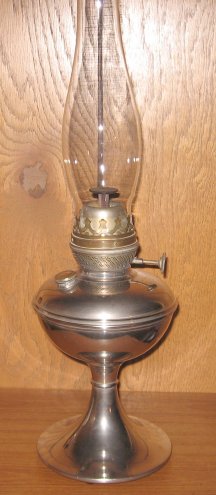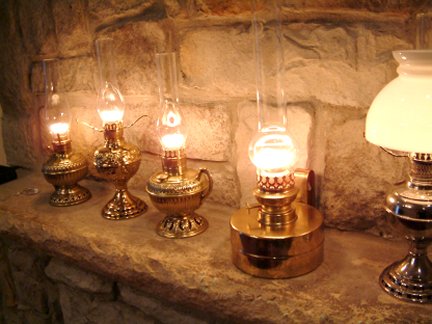Assortment of miniature lamps using wick 0L: From left to right: Rochester mini finger lamp, Plume & Atwood Little Royal, Bradley & Hubbard finger lamp, Guadard 15 Matador lamp and cut off a little in the picture, a Plume & Atwood nickel plated Little Royal with 6 shade. Owned by Alex Muzyka.Wick 0L.
The next step, of course, is to avoid the problem in the future by not using kerosene as a fuel. Paint Thinner – Low Odor Mineral Spirits, will work wonderfully well as a fuel and is clean, leaving no residue. Miles

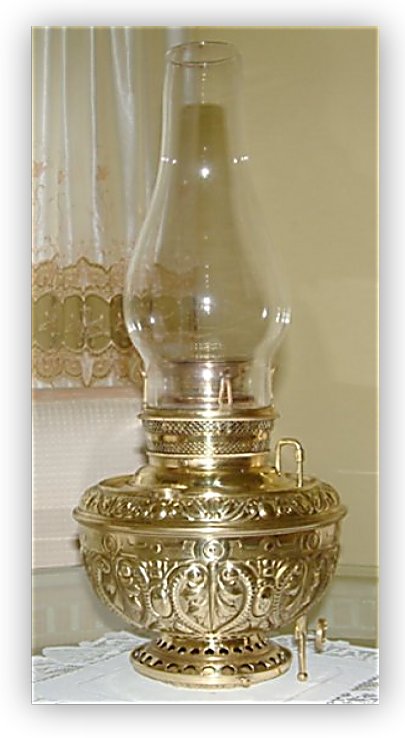
There is a link on theLinks Pagefor lamp restoration, and other quality, HONEST restorers are listed by . There is a tendency for honest, decent people to assume that others are also honest and decent. Bad assumption, as there are always crooks, thieves and swindlers that will take an opportunity to rip people off if they can. That is particularly important with lamp repairs, as usually the lamp or lantern must be sent off to a distant location for repairs by someone you have never met nor are likely to ever see. I have seen many lamps butchered by self-proclaimed experts who ruin perfectly good lamps through sheer ignorance and ego, claiming they can repair anything when in fact they are nothing but butchers.
Photos, illustrations and some information
From just after the Civil War until WW I, some of Americas finest minds were busy creating the most efficient – and beautiful! – lighting ever created. In that era before home electric lighting, center draft lamps were the ultimate in interior lighting. Every size, shape and design of lamps were designed and produced. In general, table (also called stand) lamps were the most popular because of price and availability. Banquet lamps were taller, more ornate, and often had an insert fount for fuel. To top things off, hanging lamps of ever size were made, from tiny lamps to the huge mammoth lamps. Most of the lamps made during the Victorian Era were strong, well designed lamps that are still serviceable today. Notables include the designers for Edward Miller, some of whom should be candidates for sainthood, and engineers for Ansonia, some of whom should be hung in effigy for crimes against humanity.
At left, my B & H Imperial banquet lamp, designed for placement in the middle of a long banquet table to not only light up a formal banquet room, but reflect well on the owner. This lamp is well over 2 feet high excluding the chimney. Patent date 1884. The Imperial burner unit is extremely rare, actually being aKosmos-Vulcanburner made by Wild & Wessel (Germany) using a3 5/8 wide wick. This is an extremely rare non-circular wick B&H banquet lamp.
Brass pedestal banquet lamp lineup. L – R. Parker, Hinks Annular, Veritas, Youngs Court, B&H Imperial. Some people prefer to collect ceramic banquet lamps (GWTW). I prefer brass.

Above, left: Globe Incandescent No 2.; Center above, Flame spreader indicia. Made by The Standard Lighting Co., Cleveland, O. U. S. A. Above Right; Globe Incandescent No. 2, Photo courtesy of Dick Stauffer. At left, my Globe Incandescent No. 2 burning brightly for the first time in over 70 years!!! The flame is a little ragged because this is the first burn. To protect that ultra rare, 4 1/2 wasp-waist chimney, the flame is adjusted down considerably from the light output designed into the lamp. The heat output of this lamp is sufficient to warm a room all by itself.Requires wick 3L. I now have the proper4 1/2 base, borosilicate chimneysfor the Globe Incandescent 2, Pittsburgh Mammoth and B&H 89.
Tableor stand lamps were made from the smallest 0 size for great fuel efficiency to larger, more ornate versions. The lamp in the center foreground is a Tiny Juno Hand Lamp. Far left is an ABC lamp, apparently produced pre-war in Europe, probably by the successors to Hugo Schneiders factories, as it is a steel lamp rather than brass. Middle is a Miller Vestal 1, right center a Success. Back left a P&A Royal, a B&H 1904 Perfection (it became the Rayo in 1906), and far back right is my Hugo Schneider – the last remaining 30 Blitz table lamp in the world.
The chimney holders (fingers) should be adjusted (bent) so they only gently hold the chimney in place – NOT TIGHTLY! These lamps produce a lot of heat and glass expands with heat – if gripped too tightly, the base of the chimney will break. To avoid breaking the brass fingers which hold the chimney in place, use a smooth bladed paddle pliers to bend the fingers, holding the base of the finger with needle nose pliers.
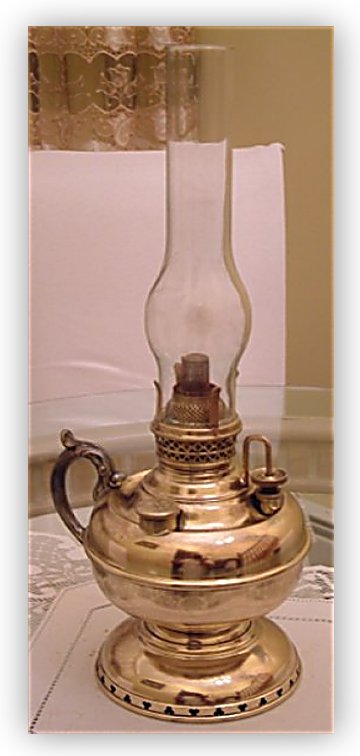
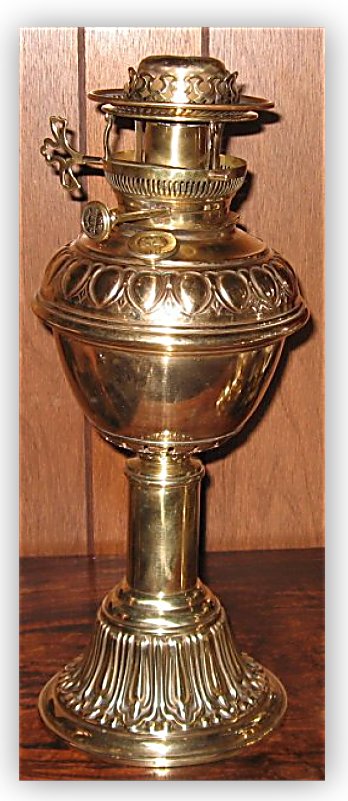
Click on any photo below to enlarge it.
During the Great Depression of the 1930s, many previously wealthy people were forced to sell off their household possessions to stay afloat, including home furnishings and decorative items. Many lamps and lighting fixtures from the Victorian period flooded the market. Otto Lightner was a regular at auctions and estate sales in Chicago, and would often purchase items for a fraction of their true value. He had a wonderful eye for quality, craftsmanship and design, thus his collection contains many true gems of the period purchased from the estates of Chicagos rich and famous, including P.D. Armour, Potter Palmer, Kate Buckingham, T.B. Blackstone, Edith Rockefeller McCormick, and others.(Click hereto see some beautiful lamps!)
Otto C. Lightner, founder of the Lightner Museum in St. Augustine, Florida, and founder of Hobbies Magazine (now. Antiques & Collecting) loved all things Victorian. A number of fine examples of 19th and early 20th century lamps and light fixtures are among his many collections on display at the museum.
At right, a beautiful Juno 3 Store lamp owned byAlex Muzyka. Far right, a collection of store lamps. Foreground, left, a Little Jewel and a Tiny Miller. Second row is a P&A Plumwood, a Radiant 5 and a Dresden. Far back right side is a Globe Incandescent 2.
Juno 3 store lamp, similar to the Rochester 3 store lamp. Owned by Alex Muzyka.
Hanging lamps were produced in all sizes. Illustrated at right are Miller lamps: Rochester Store Lamp, second model (1887), with wick adjusting rod accessible from the bottom, 4 base chimney; Miller Juno, 2 burner, 2 5/8 chimney; and far right, a Tiny Miller, 0 size burner,1.572 base chimney. The Miller Dresden (photo below) was sized between the store lamp and the 2 Juno, but the wick adjusting rod hates being poked into a table so it was not included in this photo.
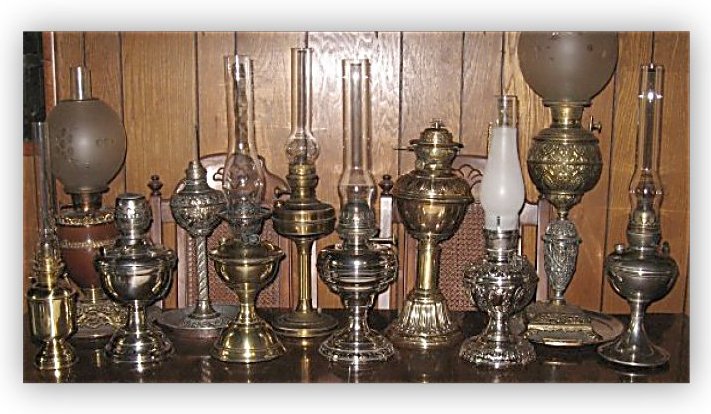
Bradley and Hubbard (B & H) is the most widely recognized name in circular wick, center draft lamps, producing these lamps beginning in 1875. B & H may have purchased lamp bases made by independent artisans (the Roycrofters movement) to fit their standard 4 15/16 burner units, as some of the bases are incredibly unique and unsigned or unmarked: by 1888, however, the company employed over 1000 people, so they also had their own in-house artisans. Due to the extremely high quality and unique beauty of these lamps, many have survived the past century in excellent condition. B & H produced the Rayo brand center draft wick under contract to Standard Oil Company. In about 1940, the Parker company purchased B & H and continued production of some less ornate B & H lamps and Rayo lamps until the early 1950s. A flood in 1955 destroyed the factory and machinery.
The P & A Royal lamp on the right has a 14 high hand painted ceramic base. The yardstick shows the size of this lamp, but it is still less tall than the lamp on the left.
Left to Right. Center draft Globe Vulcan O Table Lamp. Made by Wild & Wessel in Berlin for Cattersons, circa 1890s. Ditmar Arde pedestal lamp, Vienna, Austria, circa 1890s. Tiny Juno Table Lamp, circa 1895. Jr. Rochester Finger Lamp, circa 1886. Miller Jr. Finger Lamp, circa 1892. Baby Rochester, size . Circa 1890 Patn applied for. Extremely rare. Tiny Miller Finger Lamp, circa 1893. Tiny B&H Table Lamp, circa 1895. New Rochester Jr. Table Lamp, circa 1895. New Juno 1 Table Lamp, circa 1895. Miller 1 Vestal Table Lamp, circa 1910. Whale Oil Lamp to show size comparison.
There is a close fit on the sliding parts, with a detent on the inner part requiring the outer assembly to slide up and to the left with the detents in a groove. You should be able to see the slight ridge of the groove at about a 60 degree angle up to the left. When kerosene evaporates it leaves behind a waxy film which can harden over the years, and the evaporation also leaves a residue which is sticky.
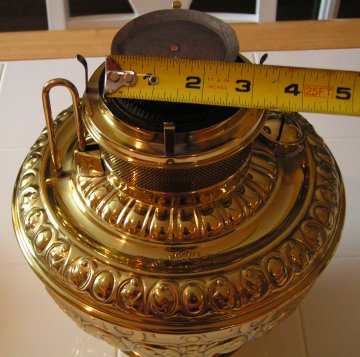
GWTW lamps are so named because of their use in the movie Gone With The Wind. Right after the intermission the women are sitting around a table while the men are cleaning out shantytown. On the table is a GWTW lamp. As the setting in the movie is shortly after CW-1, the lamp could not possibly be from that era, having actually been made at least 20 years later. Virtually by definition, GWTW lamps are 2 size center draft lamps with in a pot insert, with hand-painted ceramic or glass fonts with matching shades. As GWTW lamps were made well over a century ago, finding them complete with their shades is unusual.
From left: Veritas 20 table lamp: Veritas 20 lamp with drop-in font; Unknown lamp very similar to a Success Stand Lamp, maker unknown. Owned by Alex Muzyka.
No solvent on earth will dissolve wax, so generally heat is applied with a small torch, then the parts separated when hot with the aid of heavy leather gloves. Wax melts at approximately 150 degrees F, so not much heat is needed, certainly not enough to discolor the brass.
One of the simplest ways that often works to separate the parts is boiling water with some laundry detergent added. The detergent will dissolve any sticky residue while the boiling water will dissolve or soften the waxy residue. Detergent lowers the boiling point of water from 212 F to about 180 F, but that is still sufficient to melt the wax. Just put the burner assembly minus the wick into boiling water with detergent, boil for 15 minutes or so, then remove with tongs and separate the parts while hot and wearing leather gloves.
I have some nice GWTW lamps but nothing to compare with the magnificent GWTW Parlor Lamps of Blanka and Scott Zvorsky. The photos below are of the Zvorsky collection, with photo credits going to them. I thank them for sharing. Click on the photos to enlarge them.
The size of these lamps is deceptive in the photographs…the ruby glass shade on the B&H Radiant 4 lamp at right is 14 wide! The lamp itself is over 16 wide. I just cannot make the beautiful ruby color of the lamp shade appear correctly with my cheap digital camera. The silver B & H parlor lamp has a beautiful 8 shade, the right size for the design. Click on the photos to enlarge.
I cant thank you enough for your email, I tried the boiling water with detergent and it worked just like you said it would. Came right apart after a few minutes. Then I went over to the neighbor and got some gasoline and cleaned off the rest of it. now it work like its suppose to. so Thanks again that was a big help… I would of never guessed to do that, and probably would have bent it trying to pry it apart. that would have never worked. you got a friend in Pa… Carl
Many P & A Royal lamps used a 2 1/2 fitter for the
At left is a Success Stand Lamp 2. In the Pilabrasgo Success Oil Lamps catalogue 13 this is referred to as an S-Success, Stand Lamp Solid Brass, Nickel Plated, with Success Centre Draft Burner and Chimney. Height to top of Chimney, 22. It was just Pittsburgh Brass Co. from 1889 to 1898, then became
And here is more than just the lift gallery for my hanging Veritas! This unique Veritas gallery has the lift and also unique petals which drop over the wick as a flame extinguisher. Near right, the petals shown dropped to cover the wick, and far right, the lift system shows the petals in the up position. The flame spreader has been removed. Key lifts the gallery; lever at the back lifts a collar to deploy the petals.
ITS DIFFICULT TO imagine what life was like before electric lights. Nevertheless, before Thomas Edison perfected the electric lightbulb in 1879, people relied on gas, oil, and kerosene lamps–even candles–for light. Even as late as the 1940s, some rural communities in America were without electricity. Nevertheless, in the late Victorian period, wealthy families living in urban centers where electricity was readily available, were quick to switch from candles to electric lamps and lighting fixtures.
Just to prove there are no absolutes when it comes to center draft lamps, the photo at right shows Miller Hand Lamps in size 0, 1 and size 2 (far left).
The construction techniques used to make the lamps were also different. Many B & H lamps are found today with dents or creases in the body or top of the font, as the brass used was quite thin. Pre-1898 P & A Royal lamps, on the other hand, used brass about twice as thick, so it is rare to find a dented P & A lamp. There are experts who can unsolder the center draft tube from the bottom, gently smooth out dents, polish the parts while disassembled, then solder the parts back together, making an old dented B & H lamp look like new. Stress cracks in the body of B & H fonts are another matter all together, as the brass tank on the font inserts was a stamping and too thin for easily repairing the stress cracks…a new (old) font in good condition is usually required to salvage and use an exquisite lamp base designed for a 4 15/16 font insert.
Wicks for virtually every heater, stove and lamp made since 1850
I have tight weave English-made wicks in stock foralmost all circular wick, center draft lamps, including B&H, Rayo, Rayo Jr., P&A, Royal, Juno, all Millers, Manhattan Student Lamp, Veritas, Hinks, L&B, etc.Seewick photoat the bottom of this page.
Just when you have it all figured out, along comes a ringer to disprove all theories. All table lamps have a solid fount and are made of brass. Wrong. At right is a Hugo Schneider table lamp…which is made of steel and has an insert fount! This is reported to be the last Blitz table lamp left in the world. My Schneider was fabulously restored and has a new nickel plating by Dave Ward ofThe Village Lamp Shop.
At right is a Parker banquet lamp. Years ago I acquired a Parker insert fount in perfect condition, then waited and waited to find a good Parker banquet lamp which had been electrocuted. Finally found one, and it was worth the wait. Thankfully no holes had been drilled in the base for an electrical switch. The butchered fount was removed and replaced with my working fount, and presto, this beautiful Parker banquet lamp was back to original in its full glory! This lamp will burn on the dining room table in celebration of Christmas, 2009, probably the first time it has been lighted in many decades.
Three different circular wick lamps illustrated above. At left is a B & H Trophy lamp with a Radiant 4 burner, quite unusual and ornate. In the center is a Parker banquet lamp with insert font. The B&H Trophy lamp on the right has been electrified, but in an emergency the socket can be pulled out, the flame spreader put back in, the lamp fueled, and in less than an hour it is again a working fuel lamp: This particular B&H Trophy lamp is an extremely rare insert fount Radiant 4, undated, with only Patent Applied For on the wick raising knob: no photograph is shown in Courters Center Draft Kerosene Lamps 1884 – 1940 of an insert-fount banquet lamp with a Radiant 4 burner. Because of the tall shades, this lamps must wear my12 borosilicate chimneys.
German Intensiv Blitz Lampe, made by Bunt & Remmler in Frankfurt. Note the very unusual flared chimney. This lamp also has an air regulator on the base of the central draft tube! This is a hanging lamp set in a basket stand for photography. As with my B&H Imperial lamp, according to all reference material available this lamp does not exist – yet Alex Muzyka has one! These are the first recorded photographs of this exceedingly rare lamp. Thanks, Alex!
Thanks for sending the wicks so quickly! I wondering if you can give me some insight, I have a Rayo lamp that I can get the burner apart I have tried WD40. but it doesnt seem to be working… I was wondering if I soak the whole burner in kerosene if that might free the frozen part. the wick moves up and down fine. it just where its suppose to separate. that I cant get it to move. and i dont want to pry on it too much. Any help in this matter would be greatly appreciated. Thanks Carl
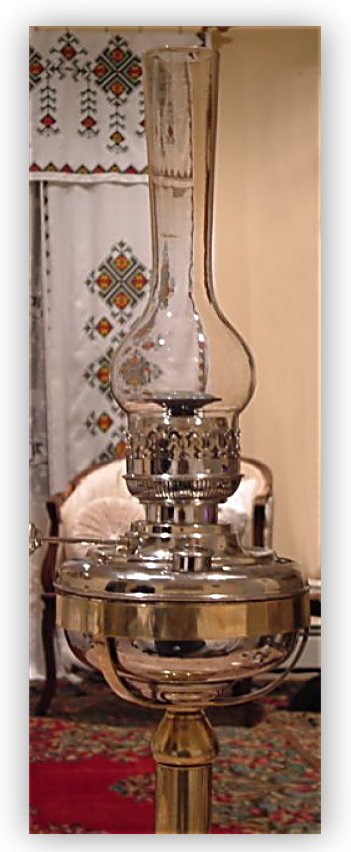
Photos of Restored LampsNewFlame Spreadersand Smoke Consumersfrom Alex Marrack
make the hanger shown on the right made to match an old catalog illustration. The size is illustrated by hanging the lamp beside a Miller Dresden 2 – the relative sizes and shapes were kept in almost perfect symmetry. Click on a photos to enlarge them.
has that unique feature of Hinks lamps – the Mortons patent iris fill cap, and a key lift gallery – the lamp can be lighted without removing the chimney and shade.[Flame spreader for this and the Veritas lamp above are from fromAlex Marrack.]
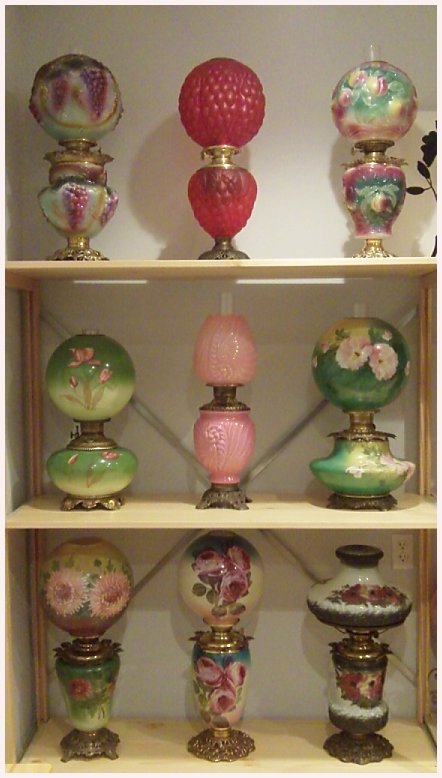
Circular wick, center draft lamps should be burned at near maximum light output to properly heat the flame spreader to burn up all fumes. If used turned down to minimum light output, theywillproduce an aroma when burning, but not when properly adjusted for maximum light output. For simple area lighting, a standard 2 burner flat wick lamp is sufficient, and the old Eagle and Banner burners made by P & A are by far the best designs.
Junior lamp lineup: Far left: Rayo Junior; 2nd from left: Miller Juno Junior; 3rd from left: Bradley & Hubbard Junior; Right: Plume & Atwood Royal finger lamp (As far as I know, the only size 1 finger lamp. Everyone else made only size 0 finger lamps). Owned and photographed by Alex Muzyka.
Far left; Rochester Tavern or Store Lamp, center,Photo of measuring lamp central air pillar.This lamp is owned and was photographed by David W. in Florida.
Table lampsHanging LampsBanquet LampsJr. Lamps-

A collection of large table lamps to show relative size. Left to right: Den Haan 14, B&H Trophy (insert fount), Hugo Schneider (insert fount), New Rochester size 0 pedestal, Veritas duplex, L&B 14 pedestal, L&B 20, Hinks 45 cp Annular, P&A Royal, B&H Imperial Banquet (insert), and Success Stand Lamp 2.

Parker lamps were manufactured from approximately 1870 until approximately 1931, but in less quantity than P & A or B & H due to their diversity into a wide variety of other products (Just try to buy a Parker side-by-side shotgun!). In 1939 – 40 Parker acquired B & H, moved their operations to B & Hs much more efficient production equipment at Meriden, Connecticut, and continued production of some models until the early 1950s.
Lamp production during the same Victorian Era time period was also underway in Europe with a number of different manufacturers inventing and producing very advanced lamp designs.L&B began makingcenter draft lamps with flame spreaderslamps prior to 1884. Indeed, L&B produced limited numbers of center draft lamps in 1883. These lamps are rare and are obvious due to the different shape of the font than subsequent lamps. The US Patent of Dec. 29.1884 by Joseph Lempereur and Lambert Bernard of Liege, Belgium (US Patent No. 333237) was clearly after the January 14, 1884 timble flame spreader patent of Leonard Hinkle (US Patent No. 292114). However,evidence existsthat L&B were making lamps using both pedestal and thimble flame spreaders in Europe prior to the introduction of flame spreaders in the US. Emil Wild of Berlin patented a lamp, chimney and flame spreader on August 19, 1884 (US Patent No. 303774) and produced an incredible variety of lamps, including his fabulousCentral Vulcandesigns. In England, Hinks, Messengers and many others were making fabulous lamps with very innovative features.
For photos of more lamps, please see thePhoto Album
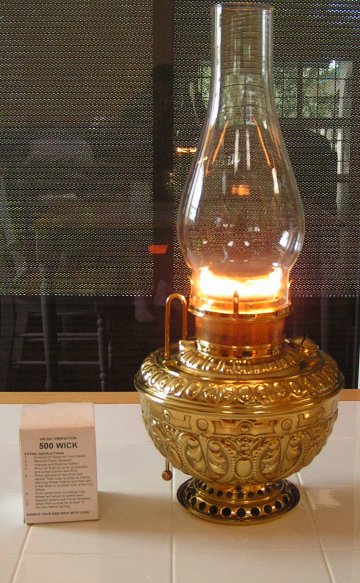
Parts for the B & H and P & A lamps arenotinterchangeable. B & H often used a burner with inside threads, whereas P & A burners quite often had outside threads, the diameters were different, etc. Spider shade holders for B & H lamps are a little too large in diameter for P & A Royal burners. Flame spreaders were of a different diameter, etc. They lamps may look identical, but they have definite subtle differences which preclude interchangeability of most parts. As both companies manufactured many different models, parts are often not interchangeable between lamps made by the same company only a few years earlier or later.
Photo courtesy of Stuart Driver of theEdward Miller & Company of Meriden, CT, USA
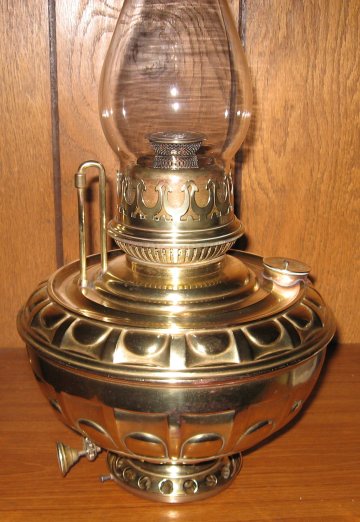
Height to shade ring – 20; to top of ball shade – 27; to top of chimney – 31. Pedestal appears to be white onyx. Photo taken before I had special2 5/8 x 12 borosilicate chimneysmade for banquet lamps with ball shades.
Kerosene is not a solvent, so soaking in kerosene is not the solution. Gasoline is a solvent and can dissolve the sticky residue left from evaporated kerosene, but as with any solvent it is flammable and must be used with care. WD-40 is a water displacement oil (WD stands for water displacement), and is not really a solvent, though it is thin enough to act as one on thicker greases… which is not the problem you have.
Please note these lamps were primarily designed as reading lamps,notarea lighting lamps, although some of the banquet lamps were very tall and designed to light up a huge banquet room. Many center draft lamps with a removable font were tall so they would spread light down and around a whole table so reading was possible from every side of the table. This feature is best illustrated by the scene in the movie Gone With The Wind, where just after the intermission the women are all sitting around a table reading while waiting for their men to return from cleaning out shantytown. That is why these lamps are often referred to as GWTW lamps even though the movie set was wrong – the first of these lamps were not in general use until 20 years after the Civil War.

Center draft lamps came with wick diameters of Baby, at 5/8, to huge store lamps requiring a 2 9/16 diameter wick. Many of these lamps were works of art and survived the lack of suitable wicks simply for that factor. Now I have wicks for virtually all of them!
At left, rare B & H Model 89 store lamp, and unlit. Owned by Alex Muzyka.
Another rare table lamp. British Hinks with an Annular (circular) wick. This lamp could well have been a one off, made especially for a client. It has a large fount fitted with a 45 cp burner, and uses aSuccess/Belgian 20 1Swick.
Center Draft Lamp WicksLamp FuelHistoryKerosene Heater Wicks
Lempereur & Bernard (L&B) Brevette lamp (Belgian), unlighted. Owned by Alex Muzyka.
[Note: The Dresden 1 and Empress 2 were stand lamps.; The Dresden 2, Liberty 2 and Empress 3 were hanging lamps – all used a wide-base flame spreader. The Liberty 1 (both stand & hanging fount) used a post-type flame spreader like the L&B. The burners were apparently copies of the L&B Belgian 20.]
Stuart Driver (Australia) has extensively studied the central draft lamps of Edward Miller and Company (Edward Miller & Company) and offers a restoration service. He is assisted by Robert Hazelton of Maine USA. Both are very well regarded for restoring Miller lamps world wide.
See alsoCare, Feeding and Restoration of Center Draft Lamps
Once separated, scour with auto polish/cleaner, which will remove any residual traces of foreign matter, and the auto polish seals the pores of the brass so reassembly is easy.
At left is a Miller Dresden, which with a different flame spreader was an Empress or a Liberty 2/0. Similar lamps were the B&H Radiant 5 and the P&A Plumwood. These lamps used an extremely efficient burner and flame spreader design to produce almost as much light as a mammoth lamp – for 1/3rd the fuel consumed. All were affordable copies of the Belgian lamp. The Little Jewel on the right is one of the smallest hanging lamps ever made. Master craftsmanDave Wardmade the harp, restored the lamp, then plated the lamp, harp and shade holder with rose gold. Wow.
Kosmos-Brenner lamps can be considered as center draft lamps for these illustrations because of the end result, but the wicks are flat. There is a separate page illustratingKosmos-Brenner lamps.
Above, far right, shows this Hinks lamp burning with a shade. Dark photo, but the photo shows the incredible size of this lamp compared to a few other table lamps.This huge lamp is over 18 high and the base is 7 in diameter: over 5 pounds of solid brass!
A rare Miller Dresden 2 hanging lamp. A store hanging lamp font but using a burner requiring a 1 1/2 wick – 2B – thicker than a Rayo wick but not as thick as a P&A Royal wick. These large lamps used the same wick raising mechanism as the New Juno. The Miller Empress is virtually identical but uses a different flame spreader. Circa late 1890s to early 1900s.From my collection.
Note the very unusual 4 1/2 fitter, wasp-waist chimney.

INSTALLING WICKS IN CENTER DRAFT LAMPS(click here)
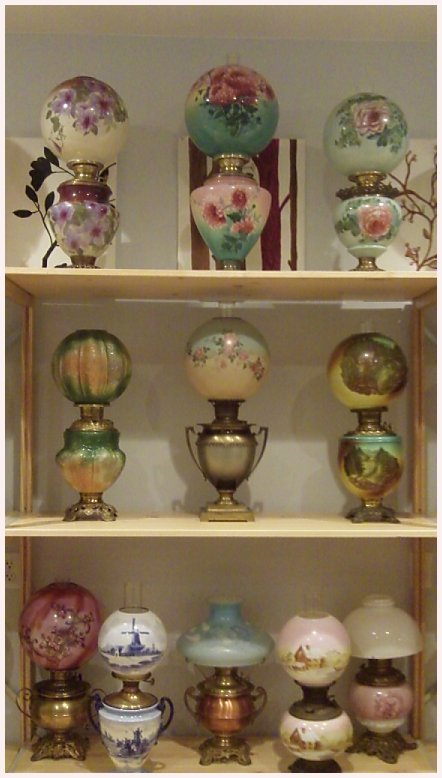
Tiny Miller Hanging Lamp, on right. As purchased it was probably intended as a wall lamp to fit into a bracket. There were Tiny Miller lamps sold in harps or hangers, but the harps or hangers are extremely rare. I had

Plume & Atwood (P & A) lamp lines included Royal, Plumwood and Naugatuck. Their burners included Banner, the Moehring and Harvard burners for finer student lamps, the Hornet, Nutmeg and Acorn burners often found on night lamps, etc. Though not now as well known as the B & H lamps, their product line was vastly more diversified and their Banner tip-over burner was extremely well designed and clean burning. P & As Risdon facility in Danbury, CT made some particularly outstanding flat wick lamps, including bicycle lamps and brooder house heaters of exceptional high quality. P&A made all the brass parts (founts and burners) for all Aladdin lamps through 1963.
A classic store lamp – plain hanger, simple steel band to hold the fount, metal shade,4 chimney. This 1st Model Rochester (1886) has a pull-rod wick raising system while the 2nd Model (1887) has a bottom lift rod (comparison photo). Far right: B&H 89 and the 1st Model Rochester. The B&H 89 was replated by Dave Ward, the Rochester has the original nickel plate.(2nd Model lighted.)
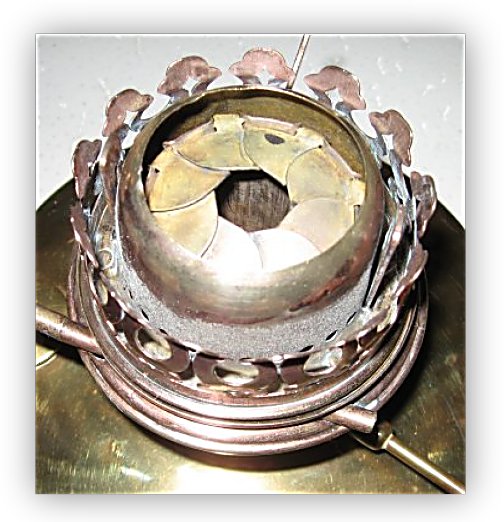
At left, Rayo Jr: Flame spreader; lamp lighted. Photographed by Alex Muzyka. Now mine!
Unique Veritas hanging lamp. Slightly pink original shade, twisted brass rods supporting of the hanging fount frame. The burner uses a 1S wick – the same wick asSuccessB&H Radiant 4Hinks 45 cpandBelgian 20lamps. The lampburns beautifully, but lighting requires removal of the chimney and filling the fount requires removal of the shade as well. This lamp is in want of alift gallerylike the Hinks shown above. [Flame Spreadersfor Veritas lamps, Lempereur & Bernard (L&B) Brevette lamps (Belgian), and Imperial/Vulcan lamps are available fromAlex Marrackin England.]
large center draft lamps will burn kerosene, but they were actually designed to burn low odor mineral spirits. The same lamp fuel is available today, but marked Paint Thinner with Low Odor Mineral Spirits. [Low Odor then meant low sulfur content.] It works just as well in center draft Kosmos lamps with the 15 burner with flame spreader or an Aladdin lamp. Virtually no odor, no tar buildup, wicks seldom have to be trimmed, the flame is a nice bright white (see lamp above on the left), and its less expensive than hardware store kerosene! It also stores extremely well.
or PILABRASGO. So this Success lamp most likely dates from sometime in the 1890s. It is in perfect condition. The new wick is shown at right burning brightly.
Miller Finger Lamp, owned by Alex Muzyka

